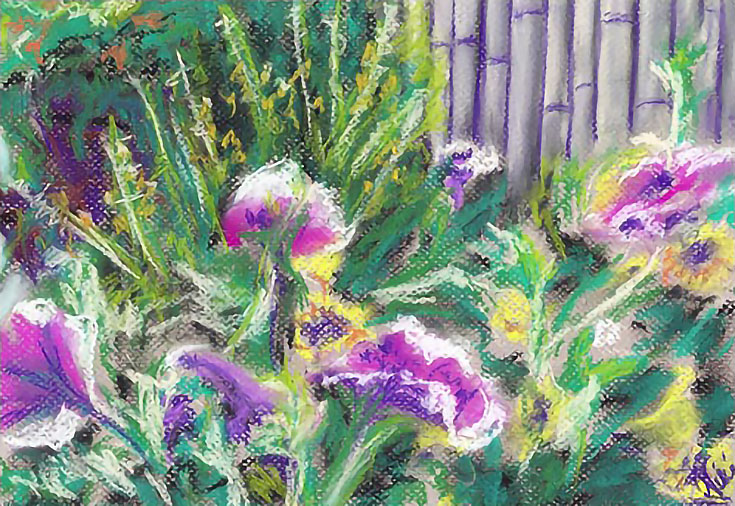Using soft pastel as a medium gives you the opportunity to choose from a variety of surfaces. But, since pastels can be used alone, blended with water, or added to mixed media pieces, it’s important to consider both your “wet” and “dry” options.
The following is a quick guide for choosing a surface for your soft pastel paintings, however you like to paint with them.
For dry pastel painting surfaces:
Soft pastels are notable for their bright colors and the ease with which they can be “smeared” to blend. They are a flexible medium, and there are a variety of surfaces suitable for dry pastel paintings.
1. Drawing paper
Drawing paper is often rough (or “toothy”) enough to hold the bright colors of pastel, and works great for quick bright sketches. It’s NOT made to hold a lot of layers, though, so if you’re planning on doing more than a quick sketch, you might want to choose a different surface.
“Flowers”—A 9×12 inch pastel on Canson Mi-Teintes paper
2. Textured Paper
Using paper created specifically to “hold” the soft pastel medium (such as Fabriano, Canson Mi-Teintes, Strathmore, U-Art sanded paper, etc) is often the traditional choice.
These papers come in a variety of textures and “bite,” meaning that some papers hold just a few layers of pastel while others are created to hold many layers of pastel. If you like a textured or layered look to your pieces, choosing a textured brand of pastel paper is a good way to go.
Textured papers also allow for easy blending of the pastel, so you can get that soft, smeared effect in your paintings along with those textured strokes.
TIP: If using a dark-toned textured paper, a broken color technique or minimal smearing often works better to showcase the pastel. A higher quality paper will tolerate more of the blending if you prefer to work on dark-toned surfaces.
3. Velour paper
For those of you who like to create a creamy, soft feel to your pastel pieces, velour or velvet paper lends itself beautifully to softly blended pastel paintings. Portrait and wildlife artists who paint in the realistic style often use velour paper to get that softly blended, professional look to their paintings.
Velour paper can be tricky to use, so if you’re just beginning with pastels, you might want to wait until you’re comfortable with your painting method before trying it.
TIP: Using pastel paper with more “bite” that is designed to hold many layers can reduce the amount of fixative you might feel the need to use (many pastel artists avoid fixative entirely). Fixative can be helpful if used carefully, but spraying it too often on your paper can backfire and leave you with a stained piece that won’t hold any more layers of pastel.
For wet pastel painting surfaces:
If you’re comfortable venturing into wet pastel territory, the following surfaces work for both wet and dry pastel with different effects.
1. Watercolor or mixed media paper
Using a high quality watercolor paper as your surface can give you a soft, well-blended effect to your pastel painting. My favorite paper for a pastel painting blended with water is Arches Cold Press, but any high-quality watercolor paper will grip your pastels nicely whether they are dry or brushed with water to blend.
“Baywood Boats”—a 9×12 inch pastel on canvas panel (blended with water)
2. Flat canvas
Also known as canvas panels or canvas board, this surface can be a tricky choice but has several advantages for the pastel artist.
First, it’s easy to hold and quite portable, making it ideal for quick studies or plein air sessions (no paper to blow in the wind!) Second, it’s capable of holding many layers, so if you like to use wet pastels and fixative this is a good choice. Third, it’s highly textured, lending a scratchy look to pastel paintings.
It also works well for the oil and chalk pastel combination, gripping the oil pastels as a resist but allowing for the blending of soft pastels over them.
Using flat canvas can be difficult for artists who like a well-blended look, so it might be a more suitable choice for artists who tend to paint in a heavily textured or nontraditional pastel style. It also still needs to be framed under glass, just as pastel paintings on paper do.
Some artists choose to paint with pastels on stretched canvas, but I can’t personally recommend this as a surface because of the difficulties in framing and preserving a pastel painting that isn’t framed under glass.
The most important thing to remember when choosing a pastel surface is that you need to find the surface that best complements your style. Don’t be afraid to experiment! The beauty of soft pastel is that it looks stunning on almost any surface, so take some time to explore the unique capabilities of this powerful medium.
This post may contain affiliate links.


